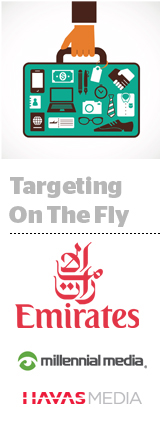 Globetrotting business travelers are a tough target to pin down, but they do all have one thing in common – their phones.
Globetrotting business travelers are a tough target to pin down, but they do all have one thing in common – their phones.
They also spend a lot of time waiting around airports connected to Wi-Fi. Emirates Airlines took advantage of the confluence with a mobile campaign designed to drive awareness and booking intent around its NYC/Dubai route on its new Airbus A380 fleet, positioning Emirates as a lifestyle brand aimed at consumers looking for luxury.
But reaching and engaging business travelers comes with attendant challenges, the biggest of which is “finding them at the appropriate/most relevant time in their purchase decision process,” said Joe Payne, an advertising specialist at Emirates in charge of media planning, brand management and corporate identity.
Because most jet-setting execs – or “globalistas,” as the airline’s agency Havas Media refers to them – are also leisure travelers, “reaching them in a business environment alone is not enough,” Payne said. “We need to catch them when they are thinking most about traveling for work.”
Emirates and Havas enlisted mobile ad network Millennial Media to help hone its targeting strategy and reach business travelers departing through three of the busiest travel hubs in the world – John F. Kennedy and LaGuardia airports in New York City and Newark Liberty International Airport in New Jersey.
App usage, real-world and online behavior, past purchases and searches, time spent on the road and other pertinent details, like whether a person is traveling solo, all went into the segmentation mix.
“We leveraged a combination of demographic data and location and layered on behavioral targeting to hit consumers while they were in the actual airport,” said Alia Lamborghini, SVP of sales for North America at Millennial Media, now a part of AOL.
The Emirates campaign ran in February and March, roughly six months before Millennial was acquired by AOL.
Using audience profiles courtesy of Millennial, affluent consumers ages 25-plus on airport Wi-Fi were targeted with expandable full-screen rich media interstitials and video ads housed within an Emirates-themed skin extolling the virtues of the carrier’s luxurious cabins, including an onboard lounge with a fully stocked bar, where passengers can mingle, snack on hors d’oeuvres and sip on cocktails.
 Like with any campaign, Havas kept a close eye on frequency to ensure the ads weren’t getting irritating and that the media buy wasn’t creating waste, said Mark Gordon, SVP and group account director at Havas.
Like with any campaign, Havas kept a close eye on frequency to ensure the ads weren’t getting irritating and that the media buy wasn’t creating waste, said Mark Gordon, SVP and group account director at Havas.
“Once a user has engaged with the campaign, we will limit exposure for an appropriate period of time and then ramp up again after an acceptable ‘rest period,’” Gordon said.
Rather than hitting the globalistas within particular apps or mobile sites – say, The Wall Street Journal, Fortune or Financial Times, publications one might expect wealthy business travelers to read – the units were targeted at the people.
“This was less about the content and more about the audience and looking at the consumers themselves, their behavior and their habits,” Lamborghini said.
Behavior and habits that are becoming distinctly mobile, Payne said.
“As mobile adoption continues to trend upward in the US, consumers are spending more and more time considering, reviewing and making travel decisions on their mobile devices,” he said. “To meet our consumers where they are consuming content, mobile has played an increasingly critical role in our media mix.”
The rich media ads netted Emirates more than 5,000 visits to its website, while the videos were viewed to completion over 170,000 times, with an overall engagement rate 3.5 times higher than Millennial’s previous benchmarks.
Although Payne declined to share sales numbers connected with the campaign, he did note that there was “a measurable impact on ticket bookings.”
Part of that was due to the ad formats, video in particular, Lamborghini said.
“Video is a great canvas in general,” she said. “But in a case like this, you especially need sight, sound and motion to illustrate the differentiated level of luxury available on an Emirates flight from New York to Dubai.”













